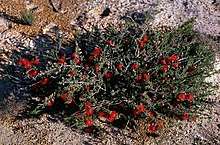Beaufortia bracteosa
Beaufortia bracteosa is a plant in the myrtle family, Myrtaceae and is endemic to the south-west of Western Australia. It is a shrub growing to a height of about 1 m (3 ft) with red to maroon flowers and woody fruit.
| Beaufortia bracteosa | |
|---|---|
 | |
| Scientific classification | |
| Kingdom: | Plantae |
| Clade: | Tracheophytes |
| Clade: | Angiosperms |
| Clade: | Eudicots |
| Clade: | Rosids |
| Order: | Myrtales |
| Family: | Myrtaceae |
| Genus: | Beaufortia |
| Species: | B. bracteosa |
| Binomial name | |
| Beaufortia bracteosa | |
| Synonyms | |
|
Melaleuca glumacea Craven & R.D.Edwards | |
Description
Beaufortia bracteosa is a compact shrub growing to a height of about 0.5–1.0 m (2–3 ft) and about 0.75 m (2 ft) in diameter. The leaves are arranged in opposite pairs and are linear in shape, 2.5–4 mm (0.1–0.2 in) long, 0.5–1.5 mm (0.02–0.06 in) wide and glabrous.[2]
The flowers are arranged in heads on the ends of the branches and have 5 sepals, 5 petals and 5 bundles of stamens. The stamens are deep pink to red or maroon and joined for about 1.5–4 mm (0.06–0.2 in) of their length into a "claw" which is hairy on one side. The 5 or 6 stamens in each claw all spread from the same point on the claw and are a further 1–4 m (3–10 ft) long. Flowering occurs throughout most of the year but especially in spring and early summer and is followed by fruit which are woody capsules 7–11.5 mm (0.3–0.5 in) long and 4.5–6 mm (0.18–0.24 in) wide.[2][3]
Taxonomy and naming
Beaufortia bracteosa was first formally described in 1904 by Ludwig Diels in Fragmenta Phytographiae Australiae occidentalis.[1][4] The specific epithet (bracteosa) is derived from the Latin word bractea meaning "scale"[5] and the suffix -osa meaning "having many (or large) bracts".[6]
Distribution and habitat
This beaufortia grows in sandy soils, sometimes with clay, gravel or loam often over laterite or granite. It occurs between Latham, Dumbleyung, the Wandoo National Park and Jilbadji Nature Reserve in the Avon Wheatbelt, Coolgardie, Esperance Plains, Geraldton Sandplains, Jarrah Forest, Mallee and Swan Coastal Plain biogeographic regions.[3][7] It is an important component of kwongan vegetation.[8]
Conservation
Beaufortia bracteosa is classified as "not threatened" by the Western Australian Government Department of Parks and Wildlife.[3]
References
- "Beaufortia bracteosa". APNI. Retrieved 19 August 2015.
- Burbidge, Andrew A. (2016). "A taxonomic revision of Beaufortia (Myrtaceae: Melaleuceae)". Nuytsia. 27: 174–176.
- "Beaufortia bracteosa". FloraBase. Retrieved 19 August 2015.
- Diels, Ludwig; Pritzel, Ernest Georg (1904). "Fragmenta Phytographiae Australiae occidentalis. Beitrage zur Kenntnis der Pflanzen Westaustraliens, ihrer Verbreitung und ihrer Lebensverhaltnisse". Botanische Jahrbücher für Systematik, Pflanzengeschichte und Pflanzengeographie. 35 (2): 431.
- Brown, Roland Wilbur (1956). The Composition of Scientific Words. Washington, D.C.: Smithsonian Institution Press. p. 682.
- "Grevillea bracteosa". FloraBase. Retrieved 19 August 2015.
- Paczkowska, Grazyna; Chapman, Alex R. (2000). The Western Australian flora : a descriptive catalogue. Perth: Wildflower Society of Western Australia. p. 349. ISBN 0646402439.
- McArthur, William Morrison (1993). History of Landscape Development (in) Reintegrating fragmented landscapes : towards sustainable production and nature conservation. New York: Springer. pp. 17–18. ISBN 9781461392163.